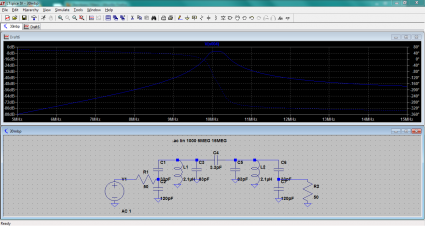I apologize. My blog has been remarkably unsociable. Whenever I post to it, I’d like it to also post a short notice to facebook and to twitter. But recently some hiccup happened, and two posts would end up on twitter, and an annoying three would appear on facebook. I think I’ve got that sorted out. Hopefully I haven’t irked too many of you, and this will work as expected from now on.
Category Archives: General
Twitter Test
A recent upgrade broke twitter updates on my blog. If you read this on twitter, it means that it’s working again.
Addendum: Sigh. Still broken. Working on it.
Kite Photography
Tom and I took a quick break after work today to try lofting my Canon camera up in the air. We used the Picavet that Tom constructed, and ran a simple uBASIC script that just took a snapshot every five seconds. We shot a total of about 120 shots, about one fourth of which were reasonably acceptable. We sent the camera up about three times with the camera adjusted three ways: the best seemed to be where the camera was adjusted to aim slightly down, below the horizon.
Check out the photos linked on Picasa below.
Digital piracy hits the e-book industry – CNN.com
Phillip Torrone pointed out a dreadful article on CNN.com today:
Digital piracy hits the e-book industry – CNN.com
A few things that I’d like to directly comment on:
“With the open-source culture on the Internet, the idea of ownership — of artistic ownership — goes away,” Alexie added. “It terrifies me.”
This is dreadfully annoying, because “open-source culture” has nothing whatsoever to do with piracy. Open-source culture is actually based upon the idea that artists should be allowed to choose (for themselves! gasp!) the conditions under which their works are used and shared. Nothing in the open source world does anything to deprive anyone of anything they own: indeed, to be enforceable, it absolutely relies on copyright law. But even more annoying is that someone can be quoted in a CNN story basically equating open source culture with piracy.
“Textbooks are frequently pirated, but so are many other categories,” said Ed McCoyd, director of digital policy at AAP. “We see piracy of professional content, such as medical books and technical guides; we see a lot of general fiction and non-fiction. So it really runs the gamut.”
Textbooks are an interesting case: they are frequently pirated for a couple of reasons. First, they are enormously expensive. Ridiculously expensive. 25 years ago when I was in college, they were expensive, but now, they are ridiculously so. What’s more is that publishers have worked hard to destroy any potential resale value for books on the used market. They do this by deliberately obsoleting books by creating only short runs of a version of a textbook, immediately replacing it with a “new version”. In order to keep all students using the same version of the text (for uniformity), professors are then required to ask that all students use the most recent and available version of the text. This drives down resale prices for the old versions, and creates a single supplier situation for the publisher. Combine this with attempts to “license” medical and legal textbooks to students, and it’s no wonder that students seek a way to reduce the $500-$1000 or more that they’ll spend on books in a semester.
Some publishers may try to minimize theft by delaying releases of e-books for several weeks after physical copies go on sale. Simon & Schuster recently did just that with Stephen King’s novel, “Under the Dome,” although the publisher says the decision was made to prevent cheaper e-versions from cannibalizing hardcover sales.
Guess what? That’s not going to work. Here’s why. Projects like DIYBookScanner already exist, and can be replicated for a few hundred bucks. Using a book scanner, any hardcover book can be converted into digital form in a matter of hours. And as (I think) Mike Godwin said, digital piracy isn’t like trying to keep cows in a corral. All it takes is one smart cow to break the copy protection or scan a book, and then thousands of other cows can follow suit. And quite frankly, there is no possible way to stop it.
Some authors have even gone as far as to shrug off e-book technology altogether. J.K Rowling has thus far refused to make any of her Harry Potter books available digitally because of piracy fears and a desire to see readers experience her books in print.
And yet, as any one with a minute to spend on bittorrent might be able to tell you, it’s not hard to find scans of any Harry Potter book. And yet, Rowling has sold gazillions of dead tree books.
Ultimately, the headline of this article is totally misleading. For all the wailing and gnashing of teeth over piracy, those who buy e-books buy more real books. Those who download music buy more music. For every negative consequence of new technology, there is a positive opportunity. Some people will realize this and benefit from this new technology, creating new markets and products. Others will try to cling to business practices which they are comfortable with, and will fight a losing battle against the new technology by annoying their customers with new annoyances to “protect” their works.
Gilbert Cell Mixer in LTSpice…
Movie Review: Sherlock Holmes
I’ve mentioned before that I’m a pretty big fan of Sherlock Holmes. Every couple of years, I dust off my copy of his stories and read them, or load them as audio books onto my iPhone and listen to them all over again. I could go on and on, but let’s just say “I’m a fan”, probably in a way that differs in relatively small degrees from fans of Marvel comics, or DC comics, or Star Wars, or Star Trek.
So, it was with some trepidation that I went to go see the new Christmas release of Sherlock Holmes starring Robert Downey Jr, Jude Law and Rachel McAdam. It’s never easy to see something that you hold in such esteem “reinterpreted”. I’m pleased to say that on the whole, I found their reinterpretation to be reasonable, if not entirely faithful to the original corpus of work. The only truly serious deviation would be the introduction of Irene Adler as romantic interest and as a thief. Irene Adler makes an appearance in Conan Doyle’s first Sherlock Holmes story, A Scandal in Bohemia, which begins:
To Sherlock Holmes she is always the woman. I have seldom heard him mention her under any other name. In his eyes she eclipses and predominates the whole of her sex. It was not that he felt any emotion akin to love for Irene Adler. All emotions, and that one particularly, were abhorrent to his cold, precise but admirably balanced mind. He was, I take it, the most perfect reasoning and observing machine that the world has seen, but as a lover he would have placed himself in a false position. He never spoke of the softer passions, save with a gibe and a sneer. They were admirable things for the observer — excellent for drawing the veil from men’s motives and actions. But for the trained reasoner to admit such intrusions into his own delicate and finely adjusted temperament was to introduce a distracting factor which might throw a doubt upon all his mental results. Grit in a sensitive instrument, or a crack in one of his own high-power lenses, would not be more disturbing than a strong emotion in a nature such as his. And yet there was but one woman to him, and that woman was the late Irene Adler, of dubious and questionable memory.
This basic tenet of the psyche of Sherlock Holmes is tragically violated in this interpretation, where there is a romantic back story between Adler and Holmes. I understand why a screenwriter might choose to introduce this in the interest of marketability, but I think it rather seriously undermines the basic premise of all the Sherlock Holmes stories. There are a number of other subtle variances from the canonical tales, but none seem as serious to me.
But I tried to drop my rigid requirements for faithfulness, and view the movie in the same way that the recent reinterpretation of Star Trek by J. J. Abrams might be viewed: are the characters interpreted in a rich, robust way which isn’t completely at odds with the original characters. And, with the exception I listed above, I’d say “yes”, but not as successfully as was done with Star Trek. Downey Jr. and Law give solid performances, but not inspired ones (we’ve seen better work from both of them). I found Rachel McAdams to be almost a distraction from the plotline, and one that really doesn’t pay off emotionally or even structurally. There are a couple of very odd continuity changes in the movie which I found inexplicable (and unable to explain without giving away too much of the plot), but on the whole, I still enjoyed the film. If you want to see a truly great, faithful adaptation of the original stories, stick to the version starring Jeremy Brett and David Burke:
Sherlock Holmes (1984 TV Series) – Wikipedia, the free encyclopedia
But if you want to see some appealing, attractive and talented actors give decent performance in a decent but not outstanding script, and if you can overlook the deviations from the original, you’ll probably be entertained and amused enough to justify the ticket price.
I give it a 7 out of 10. If I was less of a nutcase over Sherlock Holmes, I might give it another point, but I think that even barring my adoration for the original material, there are some issues with the script and story which kept it from being a stronger film. When I saw <em>Iron Man</em>, I was thinking about why I liked it afterwards, and had a difficult time describing why I enjoyed it, and this movie is similar, except with perhaps a little less compelling action sequences, and an even less convincing love story. Still, it’s an amusing time at the movies.
My first attempt at the FM transponder on HO-68
The new Chinese amateur radio satellite, formerly XW-1, now designated HOPE-1 or HO-68, made a pass with its FM transponder active around 10:00AM local time here. I was unable to get a signal through, no doubt in small part to some incompetence on my part, but also judging by the amount of doubling and piling on, from the virtual assault of RF that it was bombarded with. Nevertheless, I did get a pretty good recording of 12 minutes of the pass. The quickness with which it faded makes me believe that its transponder was simply deactivated, rather than just gone over the horizon, but I haven’t had a chance to go back to double check. As you will hear, there is no difficulty at all hearing the satellite: it’s very loud.
Actor Mickey Morton
Mickey Morton had a brilliant career. Can anyone guess why I might have stumbled across his curriculum vitae today?
Hint: I’ve just watched arguably the worst two hours in television history.
Chinese Amateur Satellite XW-1 launched, beacon has been heard…
This morning, a quick check of my email and blog roll indicated that the Chinese had launched XW-1, probably the most interesting amateur satellite to launch this year (sorry SO-67). It carries a payload with both linear and FM transponders, and it seems to have a higher orbit than current LEO satellites. It should orbit around 1200km, whereas the popular AO-51 has an altitude of only 700-800km, which should translate into a significantly larger footprint.
A couple of amateurs have recorded MP3s of the CW telemetry downlink already.
Some Document Scanner Links
I love books, and I love the fact that technology is becoming increasingly easy to get books digitized and distributed online. Several years ago I got a copy of Johnson’s Natural History that I’d love to have digitized, but as yet haven’t located anyone whose willing to do it for me. But today, I found a couple of interesting links that suggest with a modest investment, I could make a book scanner of my own. Here are some links to some projects that might be useful:
Visible Storage Event @ the Computer History Museum
If you haven’t visited the Computer History Museum in Mountain View, California, then this weekend might be a good time to go. On Sunday, they are having a special event celebrating their “Visible Storage” exhibit. This is a terrific exhibit which is going to be closed after December, in preparation for a new exhibit which I hope will be as exciting as this one. Visible Storage consists of literally hundreds of different machines and artifacts from computing history, from old style Napier bones, to the bicycle sprocket computers of Lehmer, to the Enigma machine, ENIAC, Johnniac, personal computers of every make, Crays, hypercubes, Connection Machines… A fascinating collection. If you haven’t had the chance to go see this, make sure you do before it’s gone.
Photosynth of my office…
Want to know what it is like to be me? Here is a photosynth of my office at Pixar Animation Studios. It’s my first try, combined from around 170 individual photographs. Let me know what you think.
Addendum: You’ll probably need to be running Windows to view this.
Bandpass Filters
Just some more playing around. I surfed to the following page, looking for bandpass filter designs, such as might be used at the input stage of a radio.
I took the 30m version of their filter, and created it in LTSpice, and did an AC analysis. As you can see, it’s not bad:
The only real problem for it is that it has about 6.5db of insertion loss: all signals are attenuated by this, even signals in the pass band. I haven’t quite figured out how to model the version of the same filter which has a transformer at each end yet. I’m also unsure how the Q of the inductors will enter into the evaluation of the filter. More later.
A Half Wave Filter in LTSpice
On page 3.4 of Experimental Methods in RF Design, they have a little side bar about a particularly simple form of harmonic filter that I thought I would try to analyze in LTSpice. Here’s a screen dump of the filter I designed to operate around 7.0Mhz.
It’s really pretty simple to figure out the value of the various components: if the load has a reistance of Rload, then the inductors both have the same reactance XL in ohms. The two outside capacitors also have that same reactance, while the inner one has twice the value. Combined with the formulas for the reactance of an inductor and capacitor, it isn’t hard to figure out the values.
XL = 2.0 * π * frequency * L
XC = 1.0 / (2.0 * π * frequency * C)
Performing an AC analysis, you can get the frequency response. You can see that this filter actually passes the design frequency at 0db, but is significantly attenuated at 2x the frequency, and even more so for higher multiples. Here is LTSpice’s simulation.
The Christmas Season is upon us…
Well, I spent the morning raking leaves in my front yard, and then went over to Target and got some new LED lights for our Christmas tree, and also got a new wreath. In keeping with our desire to decorate, I’ve changed the theme of my blog from its normal spartan whiteness to this holiday monstrosity of cheer. Enjoy it while it lasts, and best wishes to you all this holiday season.



